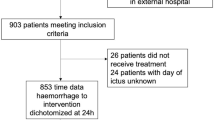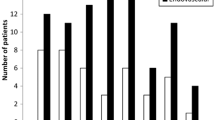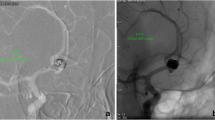Abstract
Background
We present a single-centre experience of procedural complications suffered by patients undergoing endovascular treatment for a ruptured saccular intracranial aneurysm at Tampere University Hospital, Finland, between 2000 and 2014.
Method
From 2000 to 2014, we treated 1,253 patients with aneurysmal subarachnoid haemorrhage, 491 of whom received endovascular treatment. Clinical data were collected retrospectively from the hospital’s aneurysm database. A procedural complication was defined as having occurred whenever there was a documented new event in the patient’s medical records or a note of a technical complication written by an interventionist after endovascular treatment. Procedural complications could be with or without clinical symptoms.
Results
Nearly 40% (491/1253) of the patients were treated with the endovascular method. Procedural complications occurred in 11.4% (56/491) of cases. The morbidity rate was 4.5% (22/491) and the mortality rate was 0.2% (1/491). Of the 56 complications, ischaemic complications occurred in 52% (29/56), haemorrhagic complications occurred in 27% (15/56) and technical complications occurred in 21% (12/56) of cases. In 61% (34/56) of the cases, the procedural complication did not cause any clinical symptoms.
Conclusions
The total risk for procedural complications leading to postoperative disability or death at our institute was 4.7%. The complication frequency is in accordance with previous reports. Endovascular treatment of ruptured intracranial aneurysms is a safe treatment method when patient selection is carefully performed.
Similar content being viewed by others
References
Anxionnat R, Tonnelet R, Derelle AL, Liao L, Barbier C, Bracard S (2015) Endovascular treatment of ruptured intracranial aneurysms: indications, techniques and results. Diagn Interv Imaging 96:667–675
Brinjikji W, Lanzino G, Cloft HJ, Siddiqui AH, Boccardi E, Cekirge S, Fiorella D, Hanel R, Jabbour P, Levy E, Lopes D, Lylyk P, Szikora I, Kallmes DF (2016) Risk factors for ischemic complications following pipeline embolization device treatment of intracranial aneurysms: results from the IntrePED study. AJNR Am J Neuroradiol 37:1673–1678
Clajus C, Strasilla C, Fiebig T, Sychra V, Fiorella D, Klisch J (2016) Initial and mid-term results from 108 consecutive patients with cerebral aneurysms treated with the WEB device. J Neurointerv Surg. https://doi.org/10.1136/neurintsurg-2016-012276
de Rooij NK, Linn FH, van der Plas JA, Algra A, Rinkel GJ (2007) Incidence of subarachnoid haemorrhage: a systematic review with emphasis on region, age, gender and time trends. J Neurol Neurosurg Psychiatry 78:1365–1372
Ding D (2015) Endovascular management of intracranial aneurysms: advances in stenting techniques and technology. J Cerebrovasc Endovasc Neurosurg 17:331–333
Health Quality Ontario (2006) Coil embolization for intracranial aneurysms: an evidence-based analysis. Ont Health Technol Assess Ser 6:1–114
Henkes H, Fischer S, Weber W, Miloslavski E, Felber S, Brew S, Kuehne D (2004) Endovascular coil occlusion of 1811 intracranial aneurysms: early angiographic and clinical results. Neurosurgery 54:268–280
Jabbour PM, Tjoumakaris SI, Rosenwasser RH (2009) Endovascular management of intracranial aneurysms. Neurosurg Clin N Am 20:383–398
Linfante I, Mayich M, Sonig A, Fujimoto J, Siddiqui A, Dabus G (2016) Flow diversion with pipeline embolic device as treatment of subarachnoid hemorrhage secondary to blister aneurysms: dual-center experience and review of the literature. J Neurointerv Surg 9:29–33
Lozier AP, Connolly ES Jr, Lavine SD, Solomon RA (2002) Guglielmi detachable coil embolization of posterior circulation aneurysms: a systematic review of the literature. Stroke 33:2509–2518
Molyneux A, Kerr R, International Subarachnoid Aneurysm Trial (ISAT) Collaborative Group, Stratton I, Sandercock P, Clarke M, Shrimpton J, Holman R (2002) International subarachnoid aneurysm trial (ISAT) of neurosurgical clipping versus endovascular coiling in 2143 patients with ruptured intracranial aneurysms: a randomized trial. J Stroke Cerebrovasc Dis 11:304–314
Nguyen TN, Raymond J, Guilbert F, Roy D, Bérubé MD, Mahmoud M, Weill A (2008) Association of endovascular therapy of very small ruptured aneurysms with higher rates of procedure-related rupture. J Neurosurg 108:1088–1092
Pierot L, Cognard C, Anxionnat R, Ricolfi F, CLARITY Investigators (2010) Ruptured intracranial aneurysms: factors affecting the rate and outcome of endovascular treatment complications in a series of 782 patients (CLARITY study). Radiology 256:916–923
Pyysalo LM, Keski-Nisula LH, Niskakangas TT, Kahara VJ, Ohman JE (2010) Long-term follow-up study of endovascularly treated intracranial aneurysms. Interv Neuroradiol 16:361–368
Ridwan S, Urbach H, Greschus S, von Hagen J, Esche J, Bostrom A (2016) Healthcare costs of spontaneous aneurysmal subarachnoid hemorrhage for rehabilitation, home care and in-hospital treatment for the first year. World Neurosurg 97:495–500
Spetzler RF, McDougall CG, Zabramski JM, Albuquerque FC, Hills NK, Russin JJ, Partovi S, Nakaji P, Wallace RC (2015) The barrow ruptured aneurysm trial: 6-year results. J Neurosurg 123:609–617
Steiner T, Juvela S, Unterberg A, Jung C, Forsting M, Rinkel G, European Stroke Organization (2013) European stroke organization guidelines for the management of intracranial aneurysms and subarachnoid haemorrhage. Cerebrovasc Dis 35:93–112
Taha MM, Nakahara I, Higashi T, Iwamuro Y, Iwaasa M, Watanabe Y, Tsunetoshi K, Munemitsu T (2006) Endovascular embolization vs surgical clipping in treatment of cerebral aneurysms: morbidity and mortality with short-term outcome. Surg Neurol 66:277–284 discussion 284
van Gijn J, Kerr RS, Rinkel GJ (2007) Subarachnoid haemorrhage. Lancet 369:306–318
van Rooij WJ, Sluzewski M, Beute GN, Nijssen PC (2006) Procedural complications of coiling of ruptured intracranial aneurysms: incidence and risk factors in a consecutive series of 681 patients. AJNR Am J Neuroradiol 27:1498–1501
van Rooij WJ, Peluso JP, Bechan RS, Sluzewski M (2016) WEB treatment of ruptured intracranial aneurysms. AJNR Am J Neuroradiol 37:1679–1683
Wang F, Chen X, Wang Y, Bai P, Wang HZ, Sun T, Yu HL (2016) Stent-assisted coiling and balloon-assisted coiling in the management of intracranial aneurysms: a systematic review & meta-analysis. J Neurol Sci 364:160–166
Zubair Tahir M, Enam SA, Pervez Ali R, Bhatti A, ul Haq T (2009) Cost-effectiveness of clipping vs coiling of intracranial aneurysms after subarachnoid hemorrhage in a developing country—a prospective study. Surg Neurol 72:355–360
Acknowledgements
We would like to thank Anne Simi, the study nurse, for her support in collecting the data. We would also like to thank Data Scientist Jarkko Penttinen for mastering the database.
Funding
No funding was received for this research.
Author information
Authors and Affiliations
Corresponding author
Ethics declarations
Conflict of interest
All authors certify that they have no affiliations with or involvement in any organisation or entity with any financial interest (such as honoraria; educational grants; participation in speakers’ bureaus; membership, employment, consultancies, stock ownership, or other equity interest; and expert testimony or patent-licensing arrangements) or non-financial interest (such as personal or professional relationships, affiliations, knowledge, or beliefs) in the subject matter or materials discussed in this manuscript.
Ethical approval
No formal authorisation is needed from an ethics committee for this type of study.
Informed consent
This type of study does not require formal consent.
Rights and permissions
About this article
Cite this article
Alanen, M., Pyysalo, L., Jalava, I. et al. Procedural complications of endovascular treatment in patients with aneurysmal subarachnoid haemorrhage treated at a single centre. Acta Neurochir 160, 551–557 (2018). https://doi.org/10.1007/s00701-017-3413-8
Received:
Accepted:
Published:
Issue Date:
DOI: https://doi.org/10.1007/s00701-017-3413-8




